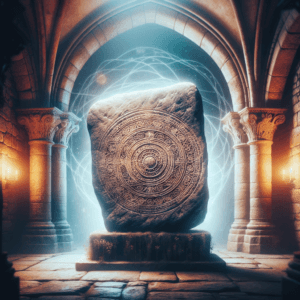What Is The Real Stone Of Destiny?
What Is The Real Stone Of Destiny? Settle in, as we are about to journey through an enigmatic tale that unfurls the mystery of the real Stone of Destiny. This article will take you on an enlightening ride, deep into the heart of history and legends, revealing fascinating insights into the origins, lore, and the present-day debates concerning this ancient object. Prepare to unveil the secrets and the intertwining stories related to the Stone, which is known to mark the ascension of monarchs and has been a symbol of power and authority for centuries. Your curiosity about the real Stone of Destiny will be well catered to, garnering a deeper understanding and appreciation for this legendary artifact.

Historical Background of the Stone of Destiny
The Stone of Destiny, also known as the Stone of Scone, is a significant historical artifact in Scottish heritage. It holds an honored position in the coronation ceremonies of monarchs and is a symbol of power and governance in Scotland.
Origin of the Stone
Your exploration starts at the Stone’s origin, deeply rooted in legend and mystery. The Stone of Destiny supposedly came from the Holy Land, where Jacob, a biblical figure, was believed to use it as a pillow. Over time, this stone evolved to be more than just a piece of rock, it served as a symbol of Scotland’s monarchy and became an artifact of great power.
Historical References and Significance
The historical references to the Stone of Destiny are immense. Many believe that the Stone confirmed the divine right of kings, granting the chosen monarch heavenly authority. It was also portrayed as a national indicator of Scotland’s independence and sovereignty, symbolizing the nation’s power over its territory and people.
Initial Location and Movement of the Stone
Initially, the Stone of Destiny was positioned in the Abbey of Scone, where Scottish monarchs were crowned. However, over time, the Stone’s location shifted to various places due to conquests, theft, and political manipulation.
Cultural Significance of the Stone of Destiny
The stone has an immense cultural impact on the Scottish people, influencing their traditions, ceremonies, and overall cultural identity.
Symbol of Scottish Monarchy
The Stone of Destiny is an emblem of the Scottish Monarchy, used in the monumental rite of ascending to governance. Every new monarch would sit on the Stone, implying their direct connection to the divine right of kings, as the stone was believed to hold a divine force.
Role in Coronation Rites
The Stone played an integral role in coronation rites, signifying the official transition of power to a new monarch. Traditionally, superintendents carried the stone during this sacred ceremony, which concluded with the new monarch sitting on the Stone as a symbol of their coronation.
Cultural Symbolism in Scotland
Beyond its political implications, the Stone of Destiny carries deep cultural significance. It symbolizes strength, permanence, and continuity, bonding past, present, and future authorities of Scotland.

Acquisition by England
The acquisition of the Stone by England marks a significant event in the historical relations between Scotland and England. This resulted in a major shift in the Stone’s location and use.
English Conquest of Scotland
The English conquest of Scotland saw the transfer of the Stone from Scottish to English possession. Seen as a symbol of triumph, the Stone was taken to England as a war trophy.
Movement of the Stone to Westminster Abbey
In England, the Stone of Destiny was kept in the revered Westminster Abbey. Its location shifted from the Abbey of Scone to its new home, where it became part of the English coronation ceremony.
Usage in English Coronations
In an adaptation of Scottish tradition, English monarchs too began to include the Stone of Destiny in their coronation ceremony. They used the Stone as a Coronation Chair, claiming the divine right of kings, similarly to their Scottish counterparts.
Controversies around the Stone of Destiny
No history is without its controversies. In the case of the Stone of Destiny, debates and disputes have arisen, adding intrigue and complexities to its tale.
Claims of Authenticity
There have been several disputes about the authenticity of the Stone. Many theories suggest that the original stone was hidden by Scottish monks and the one taken to England was a substitute.
Banishing of the Original Stone
Another controversy revolves around the supposed banishing of the original Stone. Some believe the true Stone of Destiny remains hidden within Scotland, prompting exploration and investigation from scholars and enthusiasts alike.
Historical Controversies
The Stone’s movement and usage have been points of contention, debated by historians, and used to fuel political arguments. It is not just an artifact but a marker of cultural power and nationalism, representing broader conflicts of national identity.

Modern Incident and Return to Scotland
The saga of the Stone continues in the modern era with an exciting theft and subsequent return to its homeland.
Stealing of the Stone in 1950
In 1950, four Scottish students committed a daring act of reclaiming the Stone of Destiny from Westminster Abbey. While the students were charged with theft, many Scots considered them national heroes for attempting to restore the Stone to its rightful home.
Return of the Stone
In 1996, following a lengthy negotiation process, the Stone was formally returned to Scotland. The handover occurred in a grand ceremony, fueling national pride and reigniting interest in Scottish history and culture.
Public Reaction in Scotland
The return of the Stone of Destiny was met with significant public celebration, perceived as a symbol of the recovery of national pride and identity.
Current Location and Significance
The Stone has found its residence in Edinburgh Castle, where it continues to play a pivotal role in Scotland’s narrative.
Stone in Edinburgh Castle
Housed in Edinburgh Castle, the Stone of Destiny is now a central attraction for tourists, historians, and patriots alike.
Tourism and Cultural Impact
Its location in the iconic Edinburgh Castle has bolstered Scottish tourism, attracting visitors interested in the nation’s rich history. The Stone also leaves a profound cultural impact, reinforcing its indispensable role in Scotland’s cultural fabric.
Continuing Relevance in Scottish Politics
Even today, the Stone remains valid in Scottish politics, viewed as a symbol of sovereignty and independence.

Implications for Scottish Independence
The Stone remains a powerful symbol in the ongoing debate about Scotland’s independence.
Symbol of Scottish Sovereignty
As a symbol of Scottish sovereignty, the Stone’s relevance is significant in discussions about independence. It carries centuries of history, a tangible connection to the nation’s past while potentially hinting at its future.
Role in the Scottish Independence Movement
The Scottish Independence Movement frequently references the Stone of Destiny. Seeing it as an embodiment of their quest for self-governance, many supporters consider it a crucial element of their cause.
Potential Use in Future Coronations
Should Scotland achieve independence and revive its monarchy, there may be potential for the Stone to resume its role in future coronations, furthering asserting its significance.
Scientific Studies on the Stone of Destiny
Numerous studies have sought to uncover the Stone’s truths, adding factual evidence to a tale deeply intertwined with legend and mystery.
Geological Analysis
Geologists have conducted a detailed examination of the Stone, seeking to pinpoint its origin and debunk claims of fakes.
Historical Investigations and Research
Historical studies have explored the Stone’s fascinating journey, attempting to separate fact from fiction. The Stone’s historical timeline provides unique insight into Scotland’s diverse past.
Findings and Conclusions
Despite varied findings and conclusions, the consensus is that the Stone of Destiny holds both geological and historical importance, confirming its significant role in Scotland’s heritage.

Perceptions and Interpretations
As a culturally significant artifact, the Stone of Destiny invites a variety of views and opinions.
Public Perceptions of the Stone
To the public, the Stone serves as an embodiment of Scotland’s history, culture, and identity. It’s a symbol of national pride and continues to inspire interest and intrigue.
Interpretations in Popular Culture
The Stone of Destiny has inspired various expressions in popular culture, including films and literature. It’s an artifact that continues to capture the imagination, shaping narratives and influencing perceptions.
Different Perspectives on the Stone
Among scholars and historians, the interpretations of the stone differ, giving rise to lively debate and discussion. Some see it as an artifact of divine power, while others view it as a powerful political tool.
Comparisons with Other Cultural Artifacts
The Stone of Destiny shares similar cultural value with other artifacts around the world.
Similar Roles of Artifacts in Other Cultures
Like many culturally significant relics, the Stone of Destiny holds a unique position in its national culture, deeply embedded in its history and traditions.
Comparison with Stonehenge and the Blarney Stone
Notably, the Stone shares similarities with Stonehenge and Ireland’s Blarney Stone, each carrying distinct historical importance and symbolizing their respective nations’ cultural heritage.
Understanding Cultural Artifacts in a Broader Context
Comparing the Stone of Destiny with similar artifacts from various cultures provides a broader understanding of how they shape national identity and history, inviting us to appreciate our shared human experience. Whether you’re Scottish or not, the Stone of Destiny offers a fascinating insight into Scotland’s rich and complex history.



